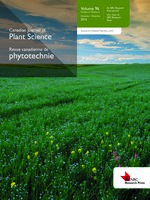Schellenberg, M. P, Biligetu, B. and Iwaasa, A. D. 2012. Species dynamic, forage yield, and nutritive value of seeded native plant mixtures following grazing. Can. J. Plant Sci. 92: 699-706. There is increasing interest in native plants of North America for rangeland reseeding in the semiarid regions of western Canada. However, there is limited information available on forage yield, nutritive value and response to grazing of seeded native plant mixture. The objective of this study was to compare foliar cover, forage yield, and nutritive value of two different native plant mixtures under grazing. In 2001-2004, a study was initiated on Orthic Brown Chernozemic (Aridic Haploboroll) soil near Swift Current (lat. 50°25'N, long. 107°44'W), Canada. The experimental design was a randomized complete block with a full factorial arrangement of seed mixtures (7 species and 14 species) and stocking rates (1.3 and 2.7 animal units ha-1) with four replications of each treatment combination. The 7-species mixture produced more forage than the 14-species mixture in July, August, and September of all study years. The 7-species mixture, however, had lower crude protein than the 14-species mixture in August and September in 2002 and 2003. Neutral detergent fiber and acid detergent fiber concentrations were generally similar between the two mixtures for July, August, and September sampling for all 3 yr. Foliar cover of awned wheatgrass [(Elymus trachycaulus (Link) Gould & Shin. ssp subsecundus (Link) A. & D. Love.] and slender wheatgrass [Elymus trachycaulus (Link) Gould subsp. trachycaulus] was higher in the 7-species mixture than the 14-species mixture, but foliar cover of other species was similar between the two mixtures. Shrub species were rarely observed in the stand at any year. Higher stocking rate decreased foliar cover of slender wheatgrass and weeds, but foliar cover of other species was similar between the two stocking rates. Based on the results, a seed mixture of native cool-season grasses may be more productive than a combination of native warm- and cool-season grasses under semiarid region of western Canada, but inclusion of warm-season grasses could improve nutritive value by increasing protein content in the late summer months.
How to translate text using browser tools
1 July 2012
Species dynamic, forage yield, and nutritive value of seeded native plant mixtures following grazing
M.P. Schellenberg,
B. Biligetu,
A. D. Iwaasa
ACCESS THE FULL ARTICLE
It is not available for individual sale.
This article is only available to subscribers.
It is not available for individual sale.
It is not available for individual sale.

Canadian Journal of Plant Science
Vol. 92 • No. 4
July 2012
Vol. 92 • No. 4
July 2012
agropyre
grazing impact
incidence de la paissance
mélanges de graines
Re-establishment
restauration
seeding mixture




